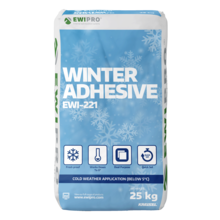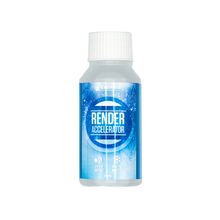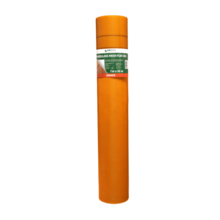
Estimated reading time: 6 minutes
As we approach Christmas in the UK, the nights are long, and the weather can get painfully cold. As such, you might be starting to think about the thermal capability of your property. Winter weather can slow a lot of construction projects due to cold temperatures and short days. These conditions slow the curing time and make it difficult for installers to work outside.
So, you might be considering what this means for the rendering process. Thankfully, there are options available for you when it comes to rendering in cold weather. In this blog, we will outline some of our top tips for rendering in winter and the various options you have available!
We’ll answer some other questions you might have, including the products you should use, minimum temperature for rendering in winter, and how to go about applying the products.
Read on to find out more about our top tips for rendering in winter!
Can you render in the winter?
Before discussing our best tips for rendering in winter, we should address a common question we get from our customers: ‘can you render in the winter?’
You might be surprised to learn that yes; you can render in winter – if you have the correct products!
At EWI Store, we have a range of products specifically geared towards winter installation, so you can be assured that your rendering project can still go ahead during the winter months!
Some products that make rendering possible in winter include winter adhesive, render accelerator, and silicone paint. We’ll discuss each of these in more detail throughout this blog!
Minimum rendering temperature
While the recommended temperature range for rendering projects varies across manufacturers, the EWI Pro range should generally not be used below +5oC and above +25oC. The reason why you should not use it in colder temperatures than +5oC is that for silicone render to cure, the water needs to evaporate out of it. The cold, often wet, weather can prolong this process by as long as 5 days (sometimes more).
Another point to consider is that silicone renders contain water. This makes them susceptible to freezing in extremely cold weather.
That said, we know sometimes jobs must be completed regardless of weather conditions. And, there are still viable options for rendering in temperatures that dip below the recommended (which is often the case in the UK!). We will outline some of these options below.
Use the best products for rendering in winter
Our biggest tip for rendering in winter, is to use the correct products. There are several products available that have been designed specifically for rendering in cold weather. These ensure that it dries correctly and limits cracking on the surface.
Mineral Render
Firstly, we would advise that you opt for a mineral-based render when rendering in the cold. For example, the EWI-060 Mineral Render. This is ideal for very cold conditions because it is the fastest drying render mix that we offer. This is because mineral render is cementitious and dries chemically, rather than water having to evaporate out of it.
We often get asked about the finish you can achieve from mineral render. The answer is that it is the same as silicone renders!
However, unlike silicone renders, mineral renders produce a dull white colour. We always recommend that you apply a silicone paint over mineral render to achieve your desired coloured finish.
Render Accelerator
Alternatively, you can opt to use a render accelerator. This works with silicone silicate, silicone, and acrylic renders. Render accelerator is ideal for rendering in cold conditions because it speeds up the drying process. This allows you to achieve a protective barrier on your external wall surface, which minimises cracking and water ingress.
The faster drying time gives you the chance to install the render before any adverse weather conditions arise. However, you should ideally ensure the few days after application are dry as this avoids render wash-off. Read more about render accelerator here!
Winter Adhesive
Finally, as the name suggests, our Winter Adhesive is ideal for rendering in cold temperatures. Winter Adhesive can be used as both a basecoat layer and an adhesive. It allows you flexibility within the rendering process as it can be used in temperatures as low as 0o C. This way, you can be assured that your rendering process can still go ahead in the winter.
But what is winter adhesive?
Winter adhesive is EWI Store’s own type of cold weather construction adhesive. It is ideal for use in cold weather as it is extremely quick drying. This type of adhesive is not recommended for use in temperatures above +12oC, as it actually dries too quickly in these conditions!
Winter adhesive can be used to embed mesh into the basecoat layer and add a durable layer to your insulation system. What's great about this product is that you only need a paddle mix to bind the dry mix with water. Then, you can apply it to your substrate.

How to apply render in cold weather
Another important tip we can offer when it comes to rendering in winter, is that you ensure it is applied correctly!
So, if you’re wondering how to go about applying render in the winter this section will explain the process according to different options.
As mentioned, we recommend using a mineral render in temperatures that are likely to dip below 0 degrees. This is useful as it is a fast-drying render. Apply using a trowel and work the render with a plastic float to get the desired finish. Then, ensure that you apply EWI-005 silicone paint afterwards to seal it and provide a decorative finish.
You should always avoid using silicone-based render in temperatures below 5-degrees. However, so long as the weather stays relatively dry, you can use a render accelerator alongside them to speed up the curing process.
When applying winter adhesive as a basecoat reinforcement layer, you should embed it with fibreglass mesh. Use a paddle mix to combine the mixture with 6.3L of water. Use a notched trowel to apply the adhesive to the back of the insulation board. Then, once the adhesive has completely dried, you can install the fixings. You can then apply the adhesive and embed it with fibreglass mesh to protect the system from harsh winter weather and UV rays.
Another useful application tip for rendering in winter is to make sure you use coverings to protect the surface from frost overnight. This allows the render to set properly and protects it from the elements.
Find out more!
In this blog, we outlined EWI Store’s top tips for rendering in winter. We found that you can render in winter if you have the correct products. Your options include:
- Using a mineral-based render.
- Applying a render accelerator alongside a silicone-based render to speed up the drying process.
- Using a winter adhesive to create a protective barrier against harsh weather and UV rays.
If you found our tips for rendering in winter interesting, you can find out which render we recommend for spring here!
You can shop all the products we’ve mentioned in our shop. If you have any questions, don’t hesitate to contact our sales team on 0203 034 0022.


